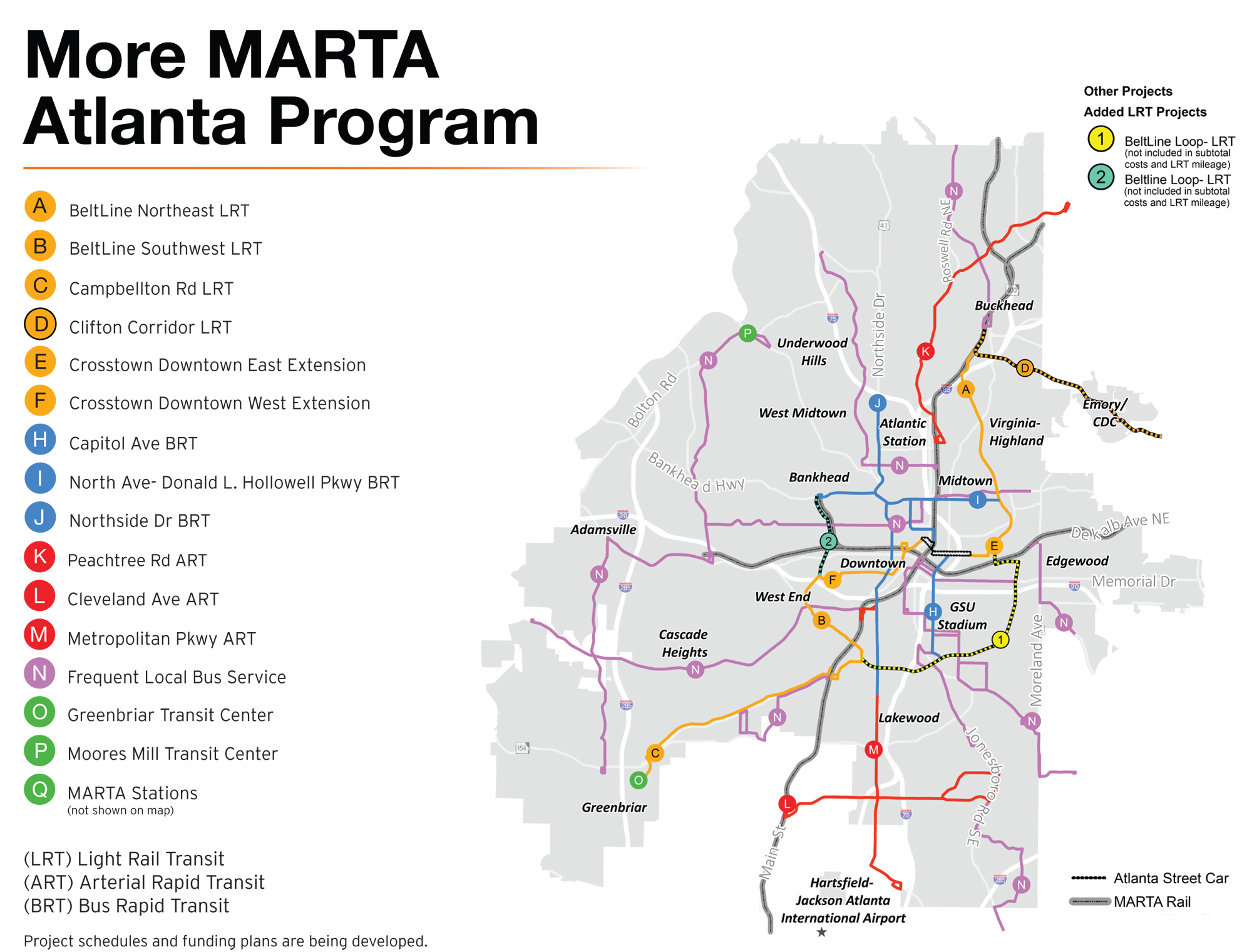ATLANTA — The Metropolitan Atlanta Rapid Transit Authority has set a timeline for a major system expansion, with projects including 29 new miles of light rail and a 2-mile extension of the Atlanta Streetcar. Jeffrey Parker, MARTA’s general manager and a veteran of the Massachusetts Bay Transportation Authority and Connecticut Department of Transportation, spoke with Trains News Wire about his view of the system’s future. These highlights have been edited for length and clarity.
Q. Why is this the right time for MARTA to set out on an ambitious expansion program?
A. Forty years ago there was a decision by a lot of smart people to invest in a heavy rail system, and over a 20-year period the system was built to what we have today. For the next 20 years, although the city continued to grow dramatically, largely the transit system has been unchanged.
Q. How has Atlanta changed in that time?
A. The state is growing rapidly, the region is growing rapidly. It’s being fueled by businesses, jobs. We have a whole host of corporate relocations that have been very thoughtful and either want to directly connect to MARTA or see the value of being very close to MARTA.
Q. How will the expansion projects be funded?
A. The shift in terms of the broad political support around investing in public transportation has changed dramatically. The city of Atlanta raised a half-cent sales tax [in 2018] to invest in expanding transit. Clayton County raised the sales tax back in 2016 and made a decision to join the MARTA district.
Q. Earlier this year, Gwinnett County voted against joining MARTA and agreeing to a one-cent sales tax for transit. [See “Suburban Atlanta county votes down transit measure,” Trains News Wire, March 21, 2019.] Was that a setback for the agency?
A. There’s a lot of talk about another referendum for that county. Fulton County has a transit plan and there’s a push to consider a referendum there, and DeKalb County is about to finish up its transit plan. I would anticipate, at some point, a referendum in DeKalb County. So, we’ve got more and more opportunities to grow and invest in transit.
Q. How were these projects selected?
A. We had to go through a prioritization process, and we did that last October, wanting to make sure that we have an equitable distribution of transit projects across the city.
So, we will have some significant corridor investment on the southern side of the city of Atlanta, like Campbellton Road light rail transit and the southwest Belt Line corridor. That is largely about serving lower income neighborhoods, making sure that we’re connecting those neighborhoods with jobs that tend to be in the urban core.
But we also have a project like the Clifton Corridor, another light rail corridor. This project will connect the heavy rail system into the second most populated job area in metro Atlanta where Emory University, Emory Hospital and the Centers for Disease Control are.
Q. How will you be using public-private partnerships, or P3s?
A. There’s a lot of opportunities around P3s and development around stations, and being able to leverage the economic development at stations to help to either supplement or fund the development of the rail system. It’s something that we’re contemplating and anticipating using as part of our portfolio of program delivery.
Q. What do you see as MARTA’s biggest challenge going forward?
A. We’ve got to improve the customer experience. We need to be service oriented. That’s about making sure that the trains are on time, making sure the stations are clean, and that it’s reliable.
Then it’s about hospitality. You want the experience to feel good, you want to feel welcomed, you want to feel like you want to come back. It’s about how we welcome our customers.
Over time, we’ve evolved from a perspective that we’re responsible for moving buses and trains to a much more holistic recognition that we’re a customer-focused organization. We’re laying out a comprehensive investment to upgrade all of our rail stations, we’re thinking about the next generation of our fare collection system to make that simpler to use and leverage better technology, and we’re trying to make our customer information system more reliable and easier to access.
Q. How do you see MARTA growing in partnership with the metro Atlanta region?
A. We’re the third-fastest growing region in the country. We’re well suited to support the city of Atlanta and the region is going to become more dense around our transit assets.
But with that growth we’re having a lot of urban displacement. People who are very transit dependent are going to be forced to move to more affordable housing in areas where we just historically have not had transit, so we’re going to have to figure out ways to react to that. That’s changing pretty rapidly in a way that has not happened historically.
Q. In January, at the annual State of MARTA breakfast, you called for a “moonshot for transit” in Atlanta. Can you explain what you mean by that?
A. We as a region really need to have some aspirational goals around investing in infrastructure. Calling for that $100 billion investment in transit, I was trying to put things in context of what other regions are investing and how they’re growing relative to metro Atlanta, and what we need to do as a region to keep up with the demand for transportation infrastructure.
This month is our 40th anniversary. It’s an exciting time in the region and an exciting time at MARTA, and we’ve got a lot of good stuff in front of us.
MARTA’s planned rail projects
Operational by 2025:
— Bankhead Station improvements: lengthening the platform to accommodate eight-car trains and growth in surrounding neighborhoods.
Under construction by 2025:
— Streetcar East Extension: Approximately 2 miles along the Atlanta BeltLine, connecting the existing Atlanta Streetcar to Ponce de Leon Avenue through intown neighborhoods Inman Park, Old Fourth Ward, and Poncey-Highland.
— Greenbriar Transit Center: a multi-modal transit hub connecting local bus service to high-capacity transit on Campbellton Road.
— Five Points Station improvements.
Planning and design phase by 2025:
— Campbellton Road high-capacity transit: approximately 5 miles from Oakland City Station to the Greenbriar Transit Center.
— Clifton Corridor Phase 1: light rail linking Lindbergh Center Station to Emory University, Emory Hospital, the Centers for Disease Control, Children’s Healthcare, and Veteran’s Administration Hospital.
— Southwest BeltLine: approximately 3.5 miles of light rail from Oakland City Station to Westview Drive near I-20, where it would connect to the future western extension of the Atlanta Streetcar.
— Northeast BeltLine: approximately 3.5 miles of light rail between Ponce City Market and Lindbergh Center Station/Armour Yard area.















